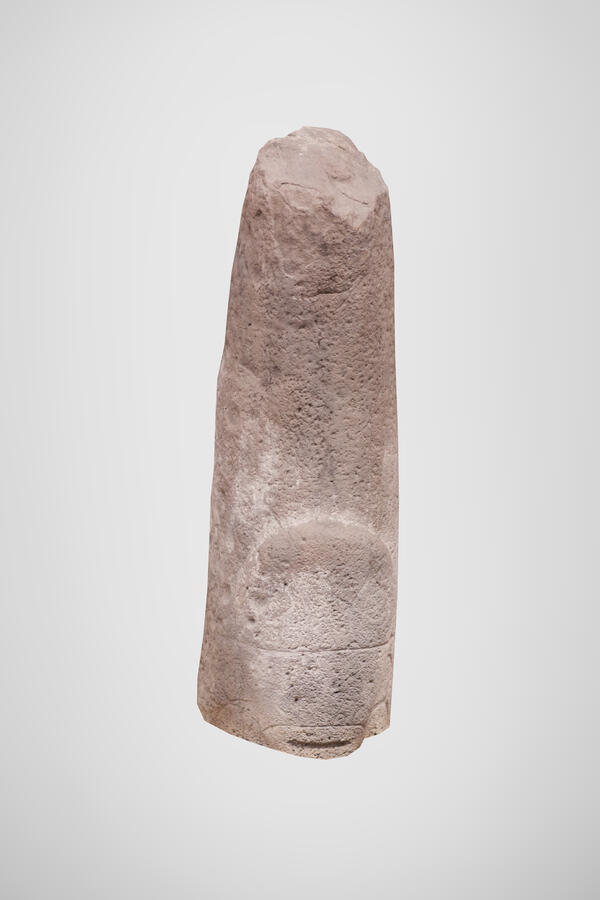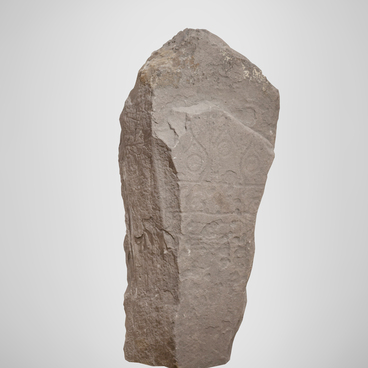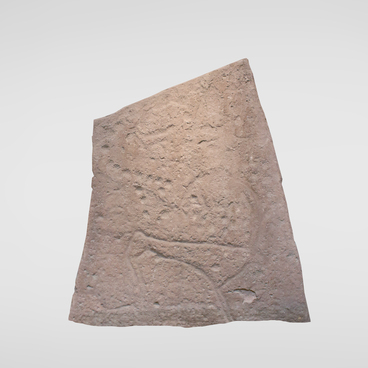One of the varieties of rock art monuments in the Tagar culture of the 8th — 3rd centuries BC were drawings on fence slabs and gravestones. Some researchers consider them to be a separate type of rock carvings, which were characteristic only of the Minusinsk Basin.
The stone statue with an anthropomorphic (humanoid) image belongs to the Early Bronze Age. Initially, it was part of the fence of a stone mound, and then it was reinstalled on the same mound as a separate stele. The statue was found in 2003 during archaeological excavations of the Chernoozernoye-2 burial ground, which was discovered in the Shirinsky region of the Republic of Khakassia. The excavations were led by Russian historian and archaeologist Andrei Gotlib.
The statue was made from a monolithic block of gray sandstone 1.5 meters high and 60 centimeters wide. In profile, it is noticeable that the pillar of the statue bends smoothly. Its entire surface has undergone careful working and abrading, but the upper part has crumbled over time.
At the bottom of the stele there is an image of an oval humanoid face. The master intentionally ground the entire surface above it to make the face appear three-dimensional: the outline of the image protrudes 4 centimetres above the body of the statue.
The features of the mask were half erased. In the upper part there are two rounded eyes, outlined in thin lines, and in the lower part, an oval deep mouth. Around the mask, the master depicted thin curved lines that diverge up and to the sides.
At the end of the 3rd millennium BC — the beginning of the 2nd millennium BC, Khakassia was inhabited by tribes that scholars refer to as the Okunev archaeological culture. Okunevites were engaged in hunting and fishing, bred and grazed cattle, mastered the skill of working copper and bronze.
Okunev faces — high stone steles on which the faces of ancient deities were carved, were a specific feature of their culture. Ritual rites and dances were performed in front of those steles. Various sacrifices were made to the deities and prayers were addressed to them.
The horizontal line that divides the mask into two halves is still the subject of scientific controversy. But most researchers agree that such masks are also a schematic representation of the universe. According to this theory, the horizontal line symbolizes the earthly world, which is located above the Lower — the underworld. The mouth of the deity in this case could mean an underground river, a kind of entrance to this underworld.
The stone statue with an anthropomorphic (humanoid) image belongs to the Early Bronze Age. Initially, it was part of the fence of a stone mound, and then it was reinstalled on the same mound as a separate stele. The statue was found in 2003 during archaeological excavations of the Chernoozernoye-2 burial ground, which was discovered in the Shirinsky region of the Republic of Khakassia. The excavations were led by Russian historian and archaeologist Andrei Gotlib.
The statue was made from a monolithic block of gray sandstone 1.5 meters high and 60 centimeters wide. In profile, it is noticeable that the pillar of the statue bends smoothly. Its entire surface has undergone careful working and abrading, but the upper part has crumbled over time.
At the bottom of the stele there is an image of an oval humanoid face. The master intentionally ground the entire surface above it to make the face appear three-dimensional: the outline of the image protrudes 4 centimetres above the body of the statue.
The features of the mask were half erased. In the upper part there are two rounded eyes, outlined in thin lines, and in the lower part, an oval deep mouth. Around the mask, the master depicted thin curved lines that diverge up and to the sides.
At the end of the 3rd millennium BC — the beginning of the 2nd millennium BC, Khakassia was inhabited by tribes that scholars refer to as the Okunev archaeological culture. Okunevites were engaged in hunting and fishing, bred and grazed cattle, mastered the skill of working copper and bronze.
Okunev faces — high stone steles on which the faces of ancient deities were carved, were a specific feature of their culture. Ritual rites and dances were performed in front of those steles. Various sacrifices were made to the deities and prayers were addressed to them.
The horizontal line that divides the mask into two halves is still the subject of scientific controversy. But most researchers agree that such masks are also a schematic representation of the universe. According to this theory, the horizontal line symbolizes the earthly world, which is located above the Lower — the underworld. The mouth of the deity in this case could mean an underground river, a kind of entrance to this underworld.



